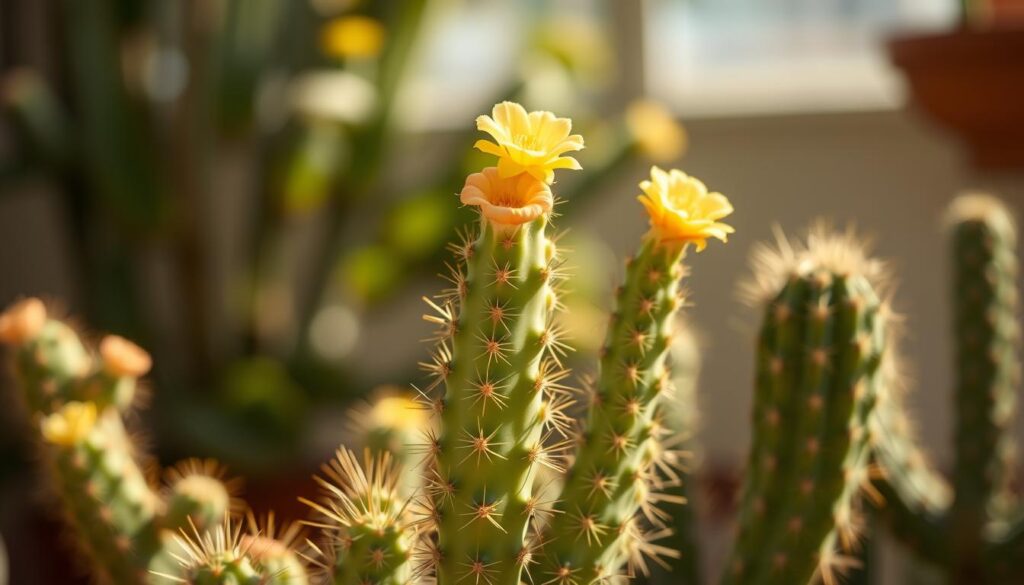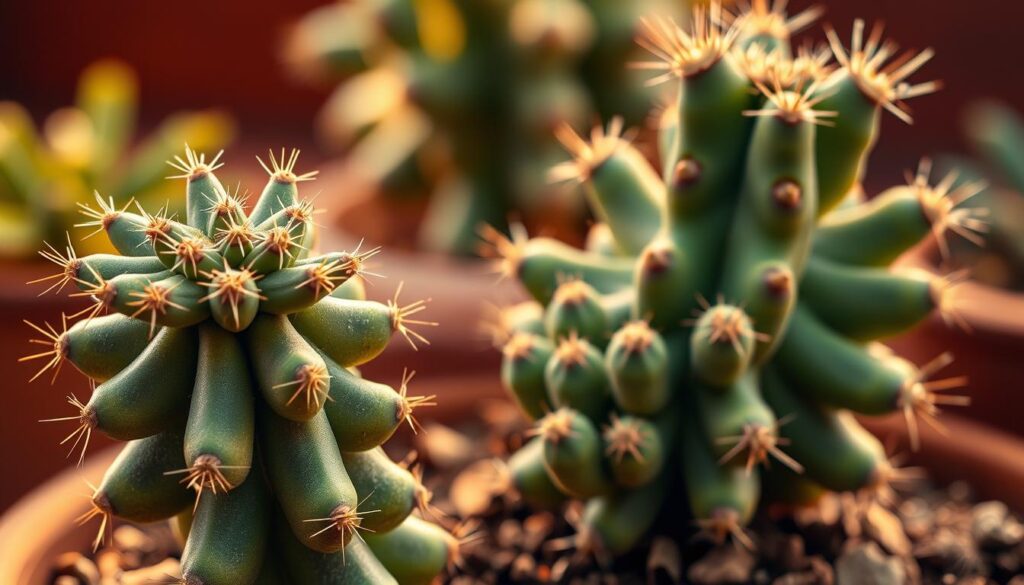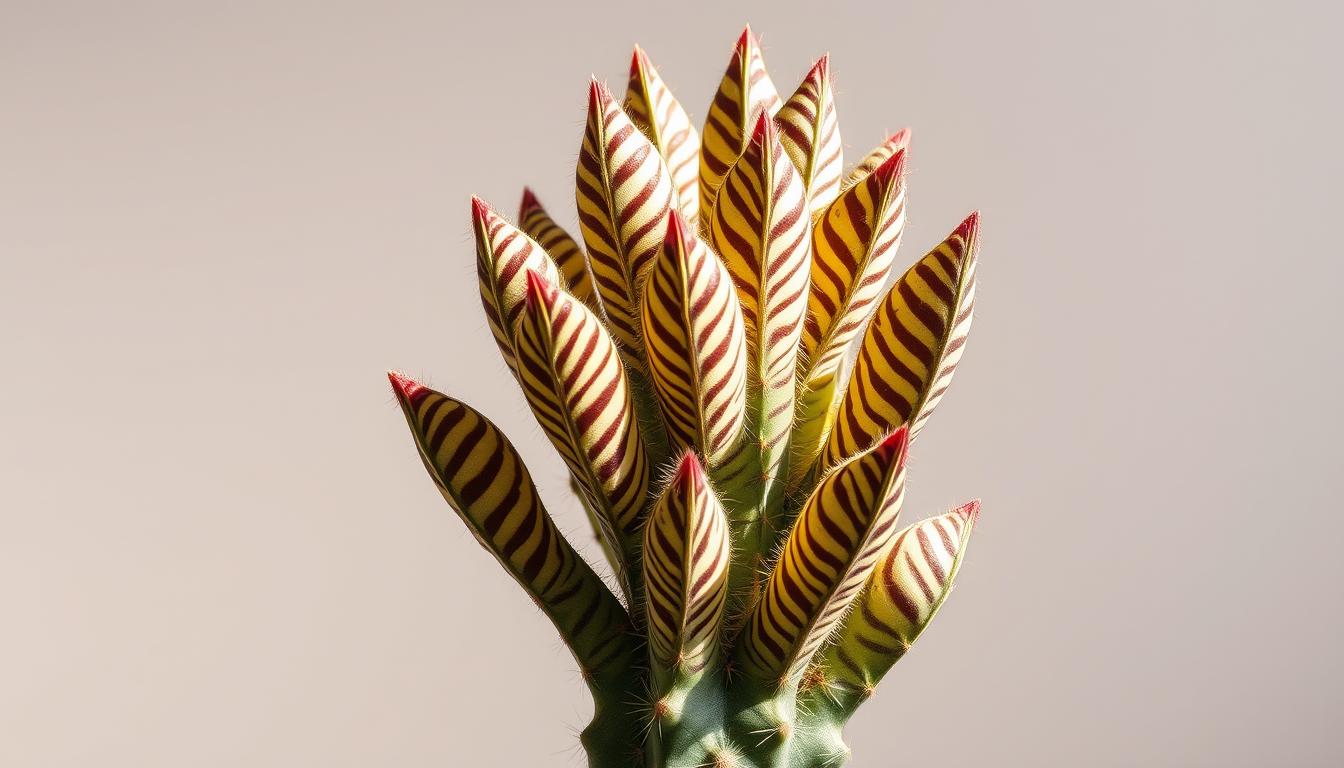Ready to learn about Lifesaver Cactus Care? It’s a great way to add beauty to your home or office. You’ll discover how to keep your plant looking its best.
Knowing what your Lifesaver Cactus needs is key to its health. It’s easy to care for, even if you’re busy. You’ll find out how to make your plant a beautiful part of your space.
Understanding the Lifesaver Cactus: A Unique Plant
Exploring the world of Lifesaver Cactus care is fascinating. This plant is known for its zebra-like stripes and can grow well with little care. To truly appreciate it, you need to know what makes it special and how to care for it.
The Lifesaver Cactus is adaptable to different environments. With the right care, it can thrive. Understanding its specific needs, like watering and lighting, is key.
What Makes Lifesaver Cactus Special?
The Lifesaver Cactus, or Huernia zebrina, is unique among cacti. It has distinctive stripes and needs little care. Its notable features include:
- Distinctive zebra-like stripes on its stems
- Ability to thrive in conditions with minimal care
- Low watering needs, making it perfect for busy plant owners
Characteristics of Huernia zebrina
Huernia zebrina is a succulent in the Apocynaceae family. It has:
- Small, globular stems with distinctive zebra-like stripes
- Short, sharp spines that provide protection from predators
- Ability to produce small, star-shaped flowers in shades of yellow and brown
Ideal Growing Conditions
To care for your Lifesaver Cactus, consider these factors:
- Well-draining soil to prevent waterlogged roots
- Bright, indirect light to promote healthy growth
- Infrequent watering to prevent overwatering and root rot
By understanding the Lifesaver Cactus, you can give it the best care. This will help it thrive and enjoy its beauty for years. Always research and meet your plant’s specific needs.
Choosing the Right Pot and Soil
When caring for a Lifesaver Cactus, picking the right pot and soil is key. The pot’s size and material, along with its drainage, matter a lot. A pot that’s too small can dry out the soil too fast. On the other hand, a pot that’s too big can make the soil too wet.
For a Lifesaver Cactus, choose a pot that breathes well and has holes for water to drain. The soil mix should hold moisture right, not too wet or too dry. A good mix for Lifesaver Cactus should:
- Drain water well to avoid soggy soil
- Keep the right moisture level
- Be porous for air to get in
When picking a pot size, go for one that’s just a bit bigger than the plant’s roots. This keeps the soil from getting too wet and lets the roots grow. The right pot and soil help your Lifesaver Cactus thrive.
By following these tips, you can create a great home for your Lifesaver Cactus. Always make sure the pot drains well and the soil breathes. This prevents problems like root rot and too much water.
| Pot Size | Soil Type | Drainage |
|---|---|---|
| Small | Well-ventilated | Good drainage holes |
| Medium | Porous material | Adequate drainage system |
| Large | Moisture-retentive | Excellent drainage system |
Watering: The Key to Thriving Lifesaver Cacti
Understanding how to water your Lifesaver Cactus is key to its health. The right amount of water is crucial. Too much can cause root rot, while too little stresses the plant.
Here are some watering tips for your Lifesaver Cactus:
- Water it more in spring and summer when it grows.
- Water less in fall and winter when it’s dormant.
- Check soil moisture by feeling it with your finger.
By following these tips, you’ll keep your Lifesaver Cactus healthy. Remember, watering is an art that needs patience and attention. With time, you’ll learn what your plant needs, and it will flourish.
Watch for these signs to know if your Lifesaver Cactus needs more or less water:
- Soft, mushy stems mean it’s getting too much water.
- Wrinkled, shriveled stems mean it’s getting too little water.
Adjust your watering based on these signs. This way, you’ll give your Lifesaver Cactus the care it needs. With the right watering and patience, you’ll enjoy your plant for many years.
| Season | Watering Frequency |
|---|---|
| Spring and Summer | Every 7-10 days |
| Fall and Winter | Every 4-6 weeks |
Light Requirements for Healthy Growth
Exploring Lifesaver Cactus care shows how vital light is for growth. The right light balance is key. Your plant needs both direct and indirect sunlight to grow well.
Here are some tips to get it right:
- Put your Lifesaver Cactus by an east- or west-facing window for soft, indirect light.
- Don’t put it in direct sunlight, especially when it’s strongest, to avoid damage.
- Use sheer curtains or blinds to soften the light and keep it cool.
By following these tips, your Lifesaver Cactus will get the light it needs. The secret to caring for it is finding the right mix of sunlight. This ensures your plant stays healthy and looks great.

Remember, light needs can change with the seasons and your plant’s specific needs. Paying attention to how your plant reacts helps it thrive. This way, your Lifesaver Cactus will flourish and show off its unique beauty.
Fertilizing Your Lifesaver Cactus
When caring for a Lifesaver Cactus, fertilizing is key. It helps your cactus grow well and look vibrant. Start by picking a fertilizer made for cacti and succulents.
A balanced, water-soluble fertilizer is best for your Lifesaver Cactus. Look for one with more phosphorus to help with root growth and blooms.
Best Fertilizers for Huernia zebrina
Good choices for cactus fertilizers include Miracle-Gro Cactus, Palm, and Citrus Food, and Schultz Cactus and Succulent Food. Make sure the fertilizer is balanced, with equal nitrogen, phosphorus, and potassium.
When to Fertilize for Optimal Growth
Fertilize your Lifesaver Cactus from spring to fall. Fertilize once a month during this time. But don’t overdo it.
Organic vs. Synthetic Fertilizers
Choosing between organic and synthetic fertilizers for your Lifesaver Cactus is a decision. Organic fertilizers like compost or manure tea are good. They give nutrients slowly and help soil health. Synthetic fertilizers give quick nutrients but might not be as good for your cactus’s health.
Propagation Techniques for Lifesaver Cactus
Exploring Lifesaver Cactus care can be exciting. You’ll learn to share your plant or grow more. A good guide will show you how to clone your cactus and grow new ones from seeds.
Propagation basics are key. Start by learning to clone your cactus through cuttings. This method lets you create exact copies of your favorite plants.
Cloning Your Cactus Through Cuttings
To clone your cactus, take a cutting from the mother plant. Make sure it has a bit of stem and roots. Plant it in a potting mix that drains well and give it the right water and light. With care, it will grow into a new plant.

Seed Propagation: Step-by-Step
Seeds are another way to propagate. Sow them in a seed tray or small pots. Keep the soil moist and warm until they germinate. For more info, check out trusted houseplant guides.
By using these techniques and caring for your plants, you’ll enjoy your Lifesaver Cactus for years. Always refer to a reliable care guide for the best results.
Pest Management: Protecting Your Lifesaver Cactus
When caring for Lifesaver Cactus, watch out for pests. Regular checks help spot problems early. Look for insects like mealybugs, spider mites, and scale by shaking the plant or examining leaves and stems.
For natural solutions, try eco-friendly pest control like neem oil or insecticidal soap. These are safe for your plant and the environment. Other natural options include:
- Garlic spray: a natural insect repellent
- Diatomaceous earth: a powder that dehydrates insects
- Cinnamon: a natural fungicide
Always test a small area first to avoid harming your plant. If pests keep coming back, get professional help to save your plant.
Stay ahead of pests to keep your Lifesaver Cactus healthy. Regular checks and care are crucial. This way, your plant will stay strong and beautiful.
Common Problems and Solutions
As a Lifesaver Cactus owner, you might face common issues. These can harm your plant’s health. Regular care is key to avoid these problems. Issues like overwatering, fungal infections, and adjusting to new environments are common.
Issues Related to Overwatering
Overwatering can cause root rot and other problems. To prevent this, check the soil moisture before watering. Stick your finger into the soil up to the first knuckle. If it’s dry, it’s time to water.
Identifying and Addressing Fungal Infections
Fungal infections often come from too much water or humidity. Look for white, cottony patches on your plant. To fix this, water less and improve air flow around your plant.
By following these tips, you can keep your Lifesaver Cactus healthy. Regular care helps prevent common issues. Always watch your plant and adjust your care as needed for the best results.
Seasonal Care: Keeping Your Lifesaver Cactus Thriving Year-Round
As seasons change, your Lifesaver Cactus needs different care to stay healthy. Knowing what your plant needs in each season is key. With the right Lifesaver Cactus Care, your plant will look great all year.
For seasonal care, think about your Lifesaver Cactus’s needs in summer and winter. Here are some tips:
- In summer, water and fertilize more to help it grow.
- In winter, water and fertilize less to help it rest.
By following these seasonal care tips, your Lifesaver Cactus will thrive. Stay alert to its needs, and with good Lifesaver Cactus Care, you’ll have a lively plant.
With the right seasonal care, your Lifesaver Cactus will stay happy and healthy. It will keep bringing joy and beauty to your space.
Sharing the Joy: Using Lifesaver Cactus in Your Space
Now that you know the Lifesaver Cactus benefits, it’s time to share it. You can show off your cactus in a creative way or start a mini cactus garden. The Lifesaver Cactus is perfect for any space, adding beauty and life.
Creative Display Ideas for Your Cactus
The Lifesaver Cactus is great for catching eyes with its unique shape and colors. Place it in a decorative pot by a sunny window or group several together for a stunning look. You can also hang it or mix it into your decor for a natural touch.
Benefits of Indoor Cacti
Indoor cacti like the Lifesaver add nature to your home and offer benefits. They clean the air, making your space healthier. Caring for them can also be calming and fulfilling.
Building a Mini Cactus Garden
If you love plants, try a mini cactus garden with the Lifesaver Cactus. Mix it with other cacti and succulents for a beautiful, easy-care display. Share your garden with others, inspiring them to explore these amazing plants.
Read about our other members of the10 Rare Houseplants That Will Transform Your Indoor Garden HERE!
FAQ




